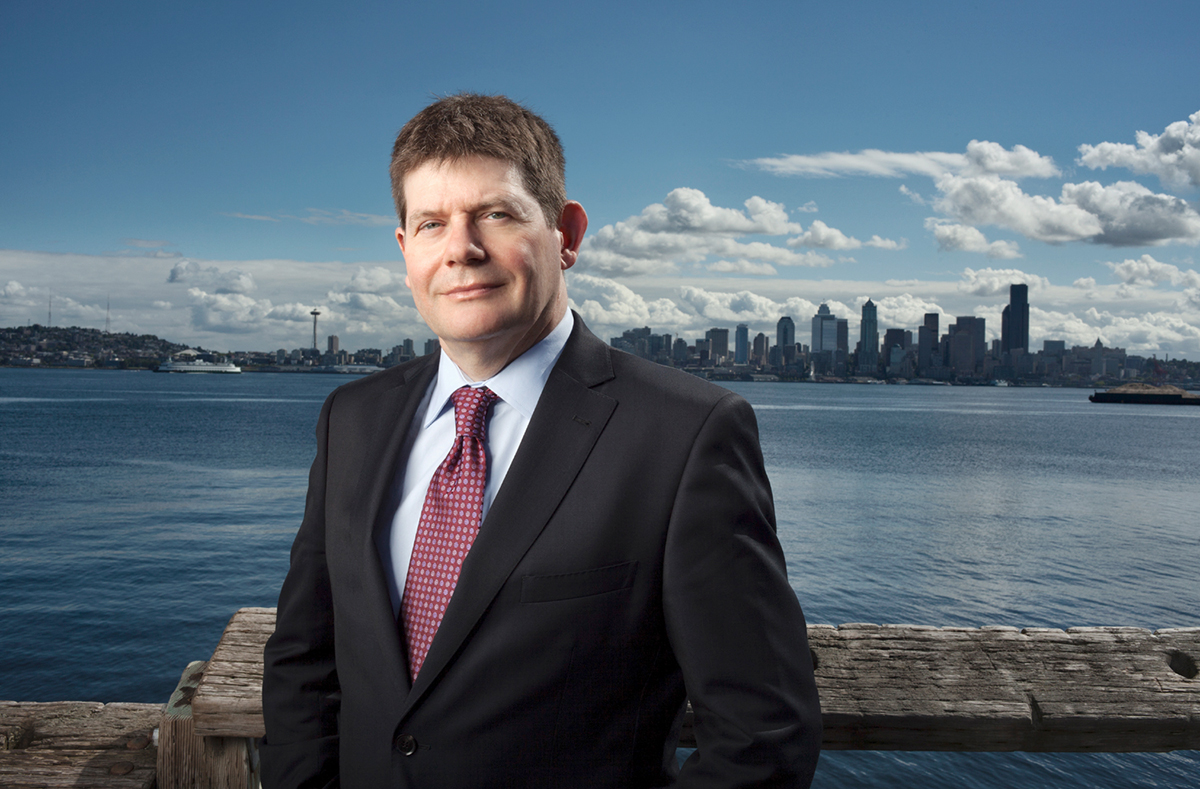“Do you have any idea?”
“No, not at all.”
“They’ve certainly done a good job keeping this under wraps.”
Such was the buzz on June 19 in the Grand Lobby of McCaw Hall. And Seattle Opera had done a good job—everyone knew the company was searching for a general manager, but it came as a surprise to many that a decision had been made. That afternoon, during a swanky reception, Board chairman John Nesholm told the gathered crowd that Aidan Lang, 56, would become SO’s third GM in its half-century history, taking the spot soon to be vacated by Speight Jenkins after 30 years.
The head of New Zealand Opera since 2006, Lang’s resume also includes work at England’s highly regarded Glyndebourne and Buxton opera festivals and at the Netherlands’ Opera Zuid. His background is in directing; he helmed Brazil’s first production of Wagner’s Ring cycle, in fact, a work at the heart of Seattle Opera’s mission. Lang will be here full-time starting next March, overlapping with Jenkins, whose official last day will be Sept. 1, 2014. The complete transition will take even longer; 2016/17 will be the first season for which the programming will be entirely Lang’s responsibility.
What might that programming look like? Even under the budget constraints of recent years, Jenkins has established a satisfying balance, almost a formula: Generally, each five-production season has included a couple of favorites to keep the accountants happy (Carmen, La boheme), a couple of top-50 not-quite-warhorses (Fidelio, Falstaff ), and a rarity (Amelia, Attila, Don
Quichotte). It’s a clever approach, comforting patrons with the standard repertory that made us fall in love with opera in the first place while broadening our knowledge.
Lang’s current NZO season looks not unlike a SO lineup: Madame Butterfly, Don Giovanni, The
Flying Dutchman, Handel’s Acis and Galatea, and Benjamin Britten’s children’s parable Noye’s Fludde (the show all the kids in bird costumes were doing in the film Moonrise Kingdom). These last two are examples of Lang’s interest in baroque opera—not a priority for Jenkins, but a draw in a city like Seattle with such a strong early-music fan base—and in Britten, the 20th century’s most wide-ranging and artistically successful opera composer. Last year, Lang led an even more intriguing project: commissioning and premiering Jenny McLeod’s Hohepa, a tale from New Zealand history exploring the Maori/British clash and bringing into the opera house a rich vein of indigenous folklore. As with SO’s 2010 premiere of Daron Hagen’s Amelia, this indicates Lang’s gratifying willingness not merely to present opera history, but to add to it.
Another question: Will Lang continue to direct? Signs are positive that his theatrical vision will mesh well with the one Seattle Opera has established. Jenkins’ oft-stated concern for singer satisfaction—what he calls the Birgit Nilsson approach, named for the soprano who once pointedly said “Songbirds sing when they’re happy”—has by no means led to stodgy, inert concerts-in-costume. (That said, Jenkins also famously has no patience for the excesses of the current European fad for Regieoper. Roughly translated as “director’s opera,” these are productions driven by an avant-garde staging concept, damn the composer’s intent: say, a Der Rosenkavalier set in Dust Bowl Kansas with the cast on Segways.)
Lang’s stage experience should ensure that SO offerings remain as vivid visually and dramatically as musically. For instance, his acclaimed 2010 production of Mozart’s The Marriage of Figaro sounds like the sort of thing I’d love to see here. One reviewer reported that “Many of the opera’s intrigues are presented in various sections of the stage, giving it a split-screen, cinematic flow . . . Bartolo’s ‘La vendetta’ is mischievously set in a kitchen, with food being chopped and cleavered behind him.” As Lang himself described his vision to set designer Robin Rawstorne, “Imagine the complex plot of this opera dancing its way through the architecture of this household, like a frenetic kid’s bouncy ball.” Photos from the production are gorgeous—period costumes in a set that’s all rectangles and ovals bathed in cool blue light.
One wouldn’t think you could immerse yourself in a specific production while overseeing an opera company’s day-to-day, but Lang managed it—especially impressive considering NZO’s tripodal structure, offering performances in Auckland, Wellington, and Christchurch, a feat that would be the equivalent, in distance, of Seattle Opera staging shows in Portland and Spokane as well as McCaw Hall.
But Lang, of course, will have to devote attention not only to what happens onstage, but how to pay for it—on a larger scale than he’s accustomed to. (SO’s annual budget is $22 million; NZO’s is $12.5 million.) One strategy he employed—frankly, an eyebrow-raiser—was to offer naming rights as part of a sponsorship. In this case, the benefactor was New Zealand’s weekly National Business Review, which is why the company’s official designation is the NBR New Zealand Opera. You can write your own jokes about what this could mean for Seattle Opera.
If he succeeds in raising the capital—in whatever way—Lang could possibly attend to some of Jenkins’ unfinished business, operas he strove to present but which the budget forbade. At the top of the list is the summer 2014 Die Meistersinger that was to have been the fervent Wagnerite’s grand farewell production, the cancellation of which broke everyone’s heart. In a recent interview in Crosscut (which I shouldn’t have read because it nearly made me ill with regret), Jenkins admitted that two 20th-century masterpieces, Berg’s Wozzeck and Shostakovich’s Lady Macbeth of Mtsensk, had recently been scheduled but shelved. For Lang to revive these plans—or restart the Young Artists Program, on hold for financial reasons—would be a huge coup.
gborchert@seattleweekly.com







